RAs pen response letter to ResLife
A private RA Town Hall served as a meeting for RAs to compose a response letter to Residential Life’s restructuring of their position.
Mallory Braden News Intern
An anonymous group of Binghamton University residential assistants (RAs) have released a response to Residential Life’s announcement to restructure the RA position next year.

The staffing announcement, originally sent out on Sept. 15, was a result of the increasing demands of University employees —especially RAs — as well as evolving student needs, according to Residential Life. The new model looks to create more than 300 new paid-staff positions in place of the current RA job. New residential positions include student support, apartment and community assistants and several hourly positions. SEE RESPONSE PAGE 3
Candela resigned on Sept. 1, after her “progressive stacking” policy came under fire last spring.
Hamza Khan and Celia Woodruff Editor-In-Chief and News Assistant
Five months after being at the center of national and international media attention for her syllabus policy, Ana Maria Candela has resigned.
Candela, a former assistant professor in Binghamton University’s sociology department, had for years implemented a “progressive stacking” policy in her course — Sociology 100: Social Change: Intro to Sociology. The policy, which stated that Candela would prioritize students in class discussions who are non-white, women or shy and quiet, prompted a Title IX complaint by a student claiming gender discrimination.
Soon after, conservative media outlet Campus Reform published a story on the policy, followed by a variety of large media outlets, including Fox News, the Daily Mail and the New York Post. While the attention has since subsided, Candela quietly resigned from her post on Sept. 1, stating she found it difficult to remain at the University.
SEE RESIGN PAGE 3
Women’s soccer extends unbeaten streak to six games
Ana Maria Candela resigns after syllabus controversy BU joins National Science Foundation consortium
IN I-Corps, aims to provide BU students with the skills
Hunter Akins and
to provide students with the skills to bring new research and technology to business markets. Led by the National Science Foundation (NSF) and Cornell University, the IN I-Corps is planned to launch in January of 2023, and will offer BU students funding, training and a network of connections to help with the creation of new research and business endeavors.
tools it provides them with to move into entrepreneurship.
Binghamton moves to 3-0 in conference play.
Jack Oh Sports Editor
On Sunday, the Binghamton women’s soccer team continued its unbeaten streak on the road against Vermont. After defeating NJIT on Thursday, the Bearcats put on a dominant offensive effort in Burlington
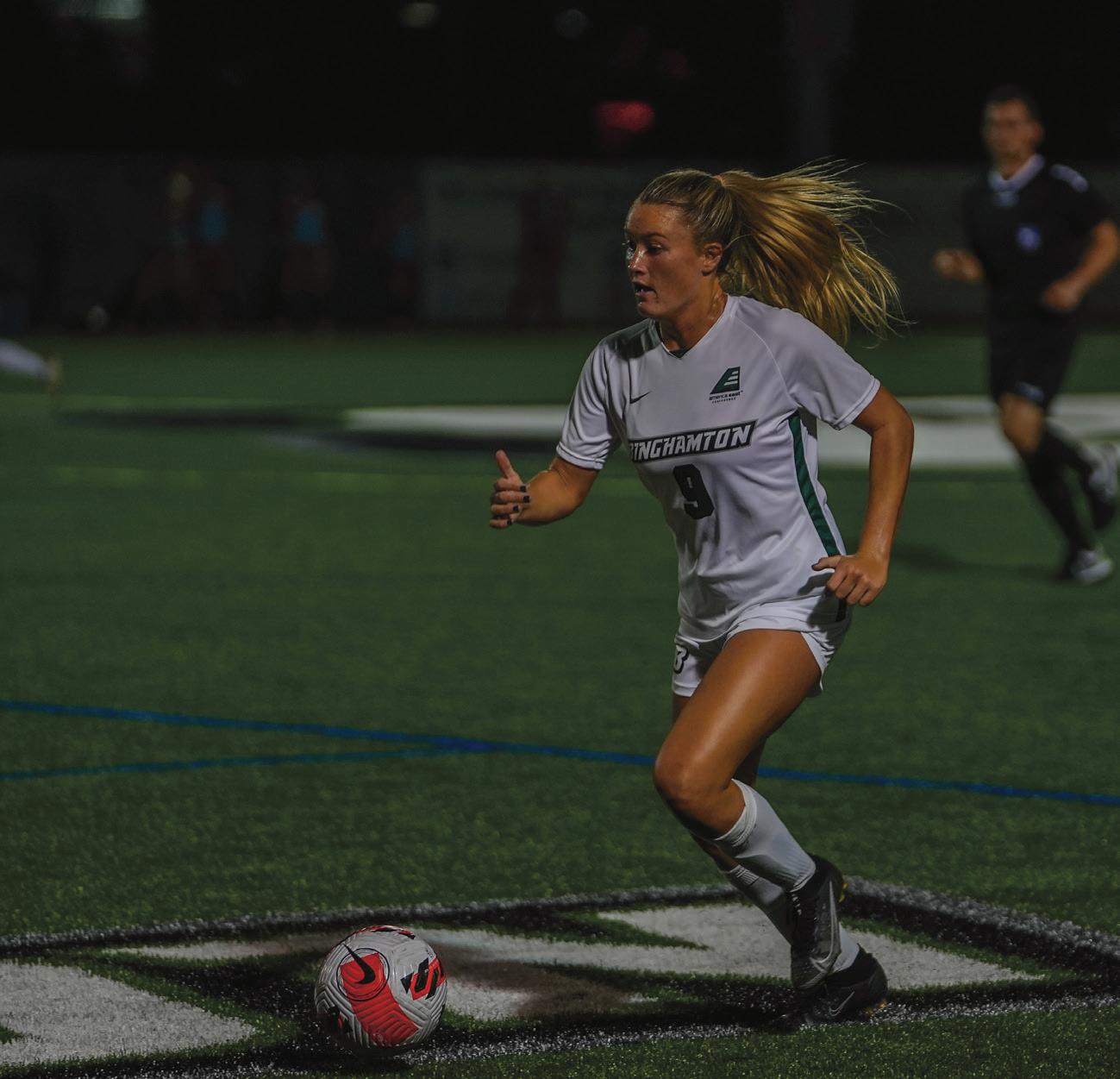
as they took care of the Catamounts 6-1, taking the sole position of first place in the conference despite playing one less game than the teams behind them.
“Very pleased with the way the team responded,” said Binghamton head coach Neel Bhattacharjee. “We were down a goal early, giving up an unfortunate [penalty kick]. So we had to show some resilience to come back from that and we did.”
ARTS & CULTURE
Amateur and professional artists showcased their work across Broome County,
New artists featured at first BUMP concert of the year, See page 9
The National Science Foundation Innovation Corps Hub: Interior Northeast Region (IN I-Corps) aims
BU’s partnership with NSF started in 2017, when it was offered a $500,000 grant to found the Innovation Binghamton I-Corps Site at the Koffman Southern Tier Incubator. Olga Petrova, director of the Innovation Binghamton I-Corps site and assistant director of entrepreneurship and innovation partnerships at BU, wrote that the I-Corps site has been beneficial for BU students and faculty due to the
“Since 2017, the Innovation Binghamton I-Corps Site program has been helping BU students and faculty learn about the basics of entrepreneurship, explore the commercialization potential of their ideas and inventions, establish and grow new startup companies and connect with experienced entrepreneurs and business mentors,” Petrova wrote in an email. “In addition, the program has been providing funding to select teams (up to $3,000) for their entrepreneurial pursuits, and supporting them in applying to the national-level NSF I-Corps Teams program, which comes with a $50,000 grant.”
Miss Asia 2022 crowned
The event showcased Asian culture and the personal talents brought by five contestants.
Jamie H. Nguyen Asst. Arts & Culture Editor
Last Saturday, Binghamton University students put on their best suits and dresses to attend Miss Asia 2022: Masquerade Ballroom. A pageant organized by the Vietnamese Student Association (VSA), Miss Asia is an annual event that aims to bring together women of various Asian cultural backgrounds, celebrating and showcasing their traditions and talents.
Apart from their snappy outfits, attendees also brought cardboard cutouts
OPINIONS
Contributing Columnist Samantha Rigante discusses the flaws of college rankings, See page 7
of the contestants, with images ranging from flattering to funny warped memes.
The usually blank Mandela Room was transformed, with a catwalk placed in the middle of the room and seats around it. There were also photo booths with VSAthemed backgrounds for pictures. True to the theme, masquerade masks were provided at the door and were a part of a raffle toward the night’s end.
Most attendees flocked to the food line after entering, which included the usual Asian dishes — mapo tofu, white rice, noodles and stir-fried veggies. And thus, with full bellies, the audience was ready to meet the future Miss Asia. The night started with an introduction to the judges and the supporting Asian organizations, both on-campus and from neighboring VSAs.
The five contestants walked out with
uproarious applause. The event featured Anita Liu, a senior majoring in English representing Taiwan, Bhea Aglibot, a junior majoring in nursing representing the Philippines, Jessica Hong, a sophomore majoring in political science representing China, Sharanya Nair, a junior majoring in integrative neuroscience representing India and SooBin Ha, a sophomore majoring in biology representing Korea.
Minh Bùi, a sophomore majoring in mechanical engineering and a cultural event coordinator for VSA, discussed the process of picking the final contestants.
“We interviewed the contestants and had them showcase to us their cultural knowledge and talent,” Bùi said. “Then, all E-Board members chose the most suitable candidate among all applicants.”
SPORTS
Women’s cross country team places 21st out of 46 teams at the Lehigh/Paul Short Run,
The Free Word on Campus Since 1946Tuesday, October 4, 2022 | Vol. CI, Issues 10 & 11 | Binghamton University | bupipedream.com
See page 8
See page 5
See page 6
Volleyball wins AE conference opener at New Hampshire,
Binghamton University has joined nine other northeastern universities in a research and entrepreneurial consortium.
SEE SCIENCE PAGE 3
to bring new research and technology to business markets
Anton Karp News Intern and News Contributor
SEE
SOCCER PAGE 5
SEE CROWN PAGE 8
Jocelyn Phipps Staff Photographer
Amid the controversy, several students organized last semester in support of Candela and her syllabus policy.
Mason Brody-Lewis Assistant Photo Editor
Senior forward Peyton Gilmore scored two goals in a 6-1 Binghamton victory against UVM.
Other top stories from bupipedream.com
Downtown Binghamton development delayed
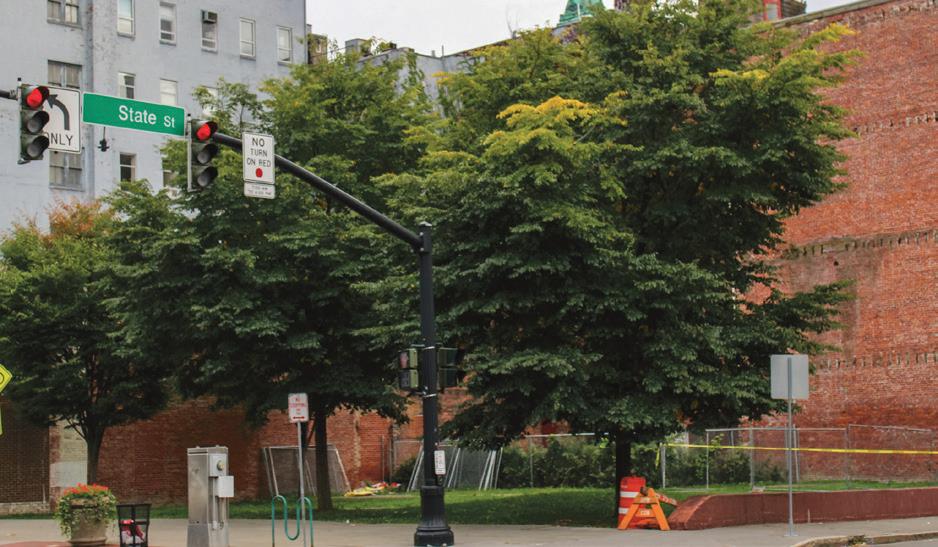
ADAM SHEMESH - OCT. 3, 2022
After announcing plans last spring, a proposed building development in downtown Binghamton has stalled out. The delays come after Visions Federal Credit Union, which was initially slated to anchor the development, pulled out of the project. This has left the project with an uncertain future.

Arts & Culture
These horror films are releasing just in time for Halloween

ISABELLA TOMASELLI - OCT. 3, 2022
With Halloween coming right around the corner, movie studios will be releasing a wide variety of horror movies including thrillers, slashers and supernatural. Jump scares, hair raising scenes and intense sequences are incoming from some of the best creative minds of today such as Guillermo Del Toro and Jordan Peele.
Men’s soccer defeats Hartford 8-1 at home
JACK OH - SEPT. 29, 2022
Despite scoring only two goals through the first eight games of the season, the Binghamton men’s soccer team exploded for eight goals in a victory against Hartford last Tuesday.
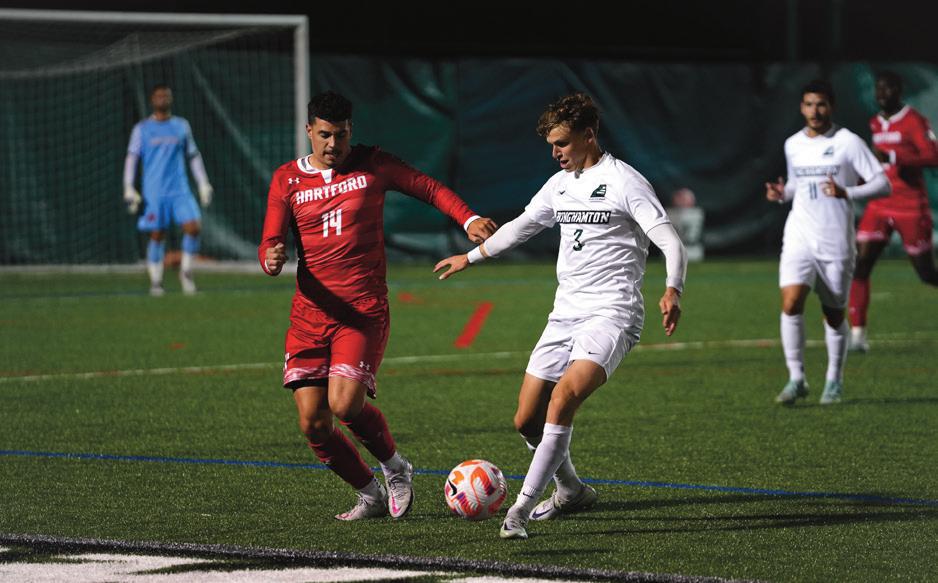
Editorial: Enough is enough
THE EDITORIAL BOARD - OCT. 3, 2022
We condemn rudeness and misconduct from students who are given the privilege of using Late Nite Service. This is not the first editorial we have written on this topic, but we hope it will be the last. Regardless of the measures or lack of measures in place, we hope that students will treat drivers and fellow riders with kindness and respect.

Monday, April 3, 2017Thursday, September 28, 2017Monday, October 2, 2017Thursday, October 5, 2017 PAGE II Tuesday, October 2022 FALL F2022 BUSINESS MANAGER Lukas Ladekarl business@bupipedream.com MANAGING EDITOR Harry Karpen manager@bupipedream.com Editor-in-Chief* Hamza Khan editor@bupipedream.com NEWS EDITOR* Jacob Knipes news@bupipedream.com ASST. NEWS EDITORS Melissa Cosovic Celia Woodruff ASST ARTS & CULTURE EDITORS Jamie Nguyen Eli Engler SPORTS EDITOR* Jack Oh sports@bupipedream.com FUN EDITOR Peter Proscia fun@bupipedream.com DESIGN MANAGER Bella Daidone design@bupipedream.com DESIGN ASSISTANTS Brianna Crowther Sonia Leyvi Alexa Valadez PHOTOGRAPHY EDITOR Michael Golann photo@bupipedream.com COPY DESK CHIEF Lia Richter copy@bupipedream.com TECHNOLOGY MANAGER Steven Yeung tech@bupipedream.com ASST. TECHNOLOGY MANAGER Leora Dallas ASST. COPY DESK CHIEF Allison Peteka ASST. SPORTS EDITORS Michael Carbone Ian Mills ARTS & CULTURE EDITOR Sam Lillianthal arts@bupipedream.com OPINIONS EDITOR Doris Turkel opinions@bupipedream.com ASST. PHOTOGRAPHY EDITOR Mason Brody-Lewis ASST. OPINIONS EDITOR Desmond Keuper ASST. BUSINESS MANAGER Adam Perez businessassistant@bupipedream.com ADDRESS: University Union WB03 4400 Vestal Parkway E. Binghamton, N.Y. 13902 PHONE 607-777-2515 W bupipedream.com stabilizing:pinochole schedule:destabilizing Pipe Dream is published by the Pipe Dream Executive Board, which has sole and final discretion over the newspaper’s content and personnel. Positions seated on the executive board are denoted by an asterisk. Pipe Dream is published online Mondays and Thursdays while classes are in session during the fall and spring semesters, except during finals weeks and academic breaks. The content on the Opinions page with bylines represent the views of those authors and do not necessarily represent the views of the Pipe Dream Executive Board. The content of advertisements do not necessarily reflect the views of the Pipe Dream Executive Board. We reserve the right to reject ads for any reason. All letters submitted for publication must include the author's name, year and major. Please limit letters to the editor to 400 words and guest columns to 750 words. Pipe Dream reserves the right to edit submissions, and does not guarantee publication. All submissions become property of Pipe Dream. Guest column submissions may be emailed to the opinions editor at opinions@bupipedream.com, and all letters to the editor may be sent to editor@bupipedream.com.
Caspar Carson Photography Intern
STANDALONE: The Illumination for Conservation Lantern Festival at the Ross Park Zoo is running through October 6.
Opinions News Sports
Sociology professor resigns after syllabus controversy
“In the handling of the progressive stacking targeted political attack and public spectacle that I experienced during the spring 2022 semester, I was treated with such callous disrespect by members of the administration of Harpur College, by [BU’s] Media and Public Relations and by a student in my course that to continue to contribute my labor to the institution would involve a profound lack of self-love and self-respect,” Candela wrote in an email.
The syllabus also stated that Candela would ask students who were white, male or “privileged by the racial and gender structures of our society” to often hold off from asking questions, in order to give priority to others. As the policy gained attention last year, Candela removed the clause from her syllabus.
Celia Klin, the dean of Harpur College, had held a meeting with Candela explaining why the language was problematic, but the professor
had not faced disciplinary action.
In a letter from Donald Nieman, former provost and academic vice president for academic affairs, the University described why it had not issued a public statement in support of Candela — a demand made by many of her supporters.
“The University supports the goal of inclusive teaching, and all good teachers strive to ensure that all students have a voice in their classes,” Nieman wrote.
“Undoubtedly, that was Professor Candela’s intent, and we applaud her for it. However, the controversy was not about Professor Candela’s intentions or even her actual teaching practices. It was about the language she included in her syllabus which is inconsistent with Professor Candela’s and [the] University’s obligations under federal law.”
Specifically, the letter said Candela’s policy had breached Title VI of the 1964 Civil Rights Act, and Title IX of the 1972 Amendments to the Education Act. While Nieman wrote that Candela’s “intention was
to be inclusive,” he stressed that the primary issue was the wording of the syllabus.
Sean Harrigan, a reporter for Campus Reform and a junior majoring in economics, had made the Title IX complaint — and was a student of the course last year. Harrigan said the news of Candela’s resignation did not affect his stance.
“My reaction to the news of her resignation is mostly indifference — my goal was never for her to be harassed, fired or pressured to leave,” Harrigan wrote in an email. “At the same time, I was disappointed in the pedagogy of the course.”
In addition to being quoted by several media outlets, Harrigan was also featured on a segment of “Fox and Friends” on Feb. 23, where he discussed the policy.
Kenyon Cavender, a teaching assistant (TA) in the course and second-year doctoral student in sociology, said Candela’s resignation would come at a cost for the department.
“Sociology is not a huge
department,” Canvender said. “It’s an absolute loss for our department and it’s felt. We know why she resigned and understand, and are sad that she’s gone. We lost a really good scholar due to this situation.”
Multiple TAs have raised the issue of privacy in their criticism of the University’s alleged lack of support, as they — along with Candela — had their names and office numbers included in the syllabus posted in the Campus Reform article.
Emily Blakely, representative of BU’s Graduate Student Employees Union (GSEU) and a sixth-year Ph.D. student studying psychology, said the GSEU was “disappointed” by the University’s “centering” of right-wing perspectives.
“Campus Reform represents a real threat, as those whose identities are exposed by them are unwillingly subjected to racist hate speech and threats of harm,” Blakely said. “This has lasting implications from employees who have to return to the classroom and are forced to continue to work in hostile and
unsafe work environments.”
In regard to the syllabus clause itself, students expressed a range of responses, with the Latin American Student Union (LASU) holding a protest in favor of Candela last month.
Some, like Adam Tartasky, a junior majoring in psychology who had taken Candela’s course, said they supported the policy — which Tartasky said supported “underrepresented” students.
“I found it odd that the student that felt the need to go to the local conservative tabloid media was given so much attention for voicing a grievance that, from my observation, held no discernible truth to it,” Tartasky said. “The individual that complained against Professor Candela was in my class, and in my discussion group, and was routinely called on despite his broadly unpopular comments.”
Others, like Danyal Shah, a senior majoring in biochemistry, said the clause should not have been encoded within the syllabus.
“I can understand that she
might want to hear more unique perspectives in discussion, but the policy didn’t need to be outlined in the syllabus,” Shah said. “It sounds like a common unwritten rule that a lot of professors use.”
The sociology department has also seen a recent change in leadership, now chaired by Ji-Song Ku, an associate professor in the department of Asian and Asian American Studies. Ku said his appointment was not related to the syllabus controversy.
With Candela no longer a part of the department, Tartasky said he would miss his experiences with her as an instructor.
“I will be forever grateful for the lessons learned inside and outside of Professor Candela’s classroom, and that I was fortunate enough to be a student of hers,” Tartasky said. “It would be an understatement to say that she made me a better person.”
RAs respond to new Residential Life staffing model
Ryan Yarosh, senior director of media and public relations at BU, said the goal of the new structure is to improve the working environment for such student employees. Yarosh explained that this decision was a result of conversations with and exit surveys from former RAs.
“The new model is designed to reduce the demands upon any one role,” Yarosh wrote in an email. “Two-thirds of RAs indicated that the RA position led to burnout. Burnout was also the second most commonly cited reason for RAs not returning, second only to graduation.”
Yarosh added that Residential Life is fully committed to engaging with RAs as the new student staff model continues to be developed, mentioning that several meetings with current RAs have already been scheduled for students to give their feedback.
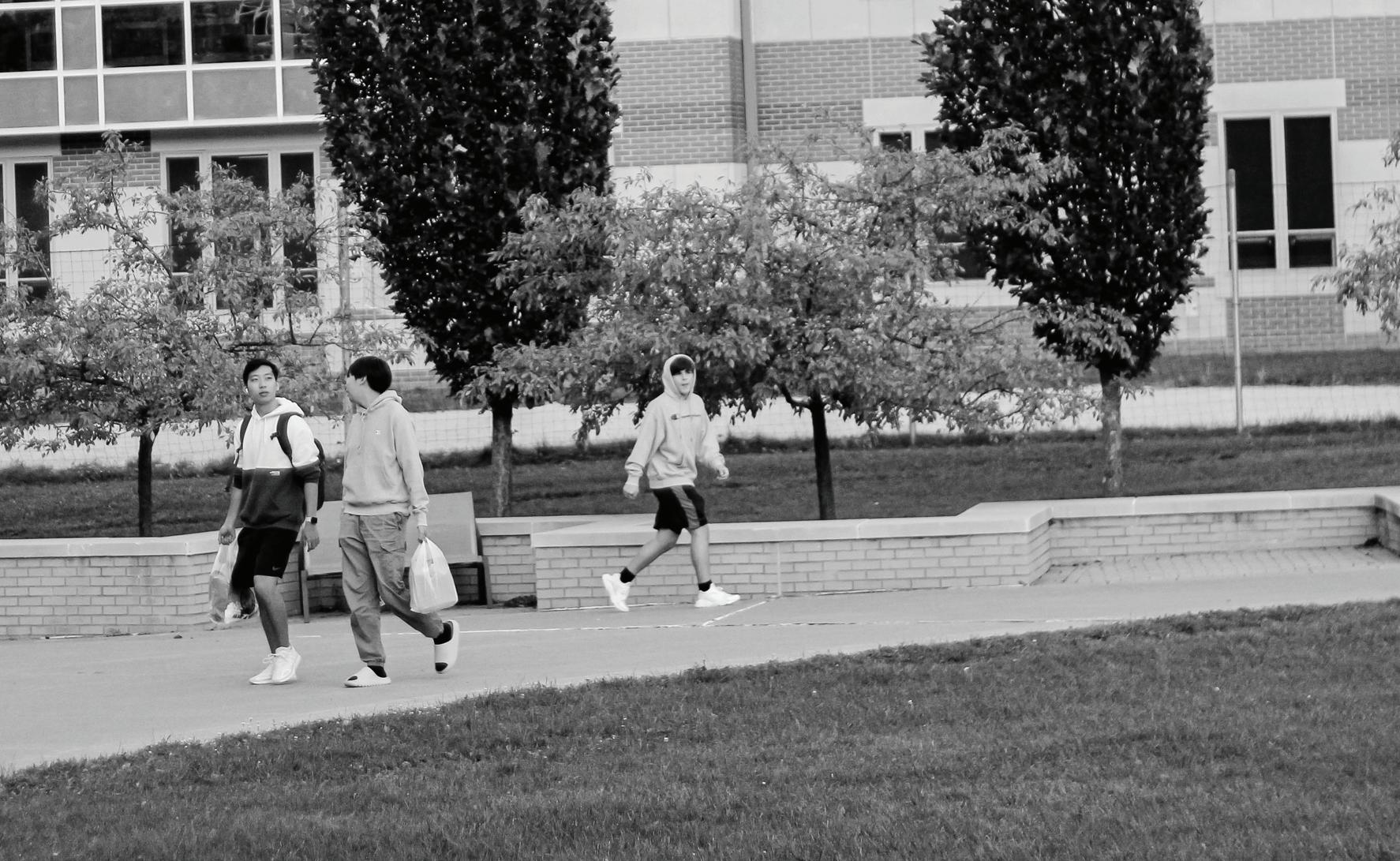
Following the announcement, a private RA “Town Hall” was held on Sept. 18 for RAs to voice their concerns with the new model. RA’s present also discussed what the change may mean for their jobs and those of future students. During the meeting, a group of RAs — all of whom wished to remain anonymous to protect their employment — drafted their response to Residential Life’s decision, which they released as an open letter on Sept. 21.
“RAs demand that we have a proper seat at the table and that any updates from the status quo not be finalized without tangible input from RAs,” the letter reads. “As the workers who directly interact with the people Residential Life serves, adding our perspective is in Residential Life’s best interest as well as the best interests of many other stakeholders. We call on central Residential Life to open an invitation to all RAs for negotiation on any updates to the Residential Life student staff model.”
Additionally, the letter said that if requests to be more involved in the decision-making processes are denied, RAs will warn prospective students, families and the community about what they consider to be the “risks posed.”
Some concerns expressed in the letter were that the new staffing model is failing to look through an intersectional lens when thinking about the students affected.
Specifically, the letter suggested that students of marginalized backgrounds and first-generation students would be most affected by the change.
During the meeting, an RA, who wished to remain anonymous, expressed that many of their residents had been relying on eventually becoming an RA to sustain their education.
“I have received a ton of
interest from some of my residents about wanting to become RAs because they know how valuable their room and board being covered is,” the anonymous RA said. “When I told them that [Residential Life] is changing the whole system and a lot fewer people are going to get that position next year, they were super disappointed. Because a lot of students are relying on that to pay for college, especially if they’re from out of state. It is really pulling the rug out from under a lot of kids that need this financial assistance.”
Avery Benzaken, a BU Council representative and second-year graduate student pursuing a master of business administration, raised the issue to administration in a recent BU Council meeting.
Benzaken said he believes RAs have exceeded expectations the past few years, especially when dealing with COVID-19 protocols on campus.
“This is proving that what they do for students goes far beyond any job description,” Benzaken said. “RAs have really worked together to create a network of students that are delivering food to students that aren’t able to go into isolation housing.
The complaints voiced by RAs in opposition to the new structure has definitely just highlighted greater issues within Residential Life on the supervisory side of things. If this new structure is going to be implemented successfully, we need

to get our students on board and our RAs on board.”

Benzaken said he has been keeping himself posted on the situation via Instagram, as well as speaking to University administrators. He added that there seems to be a strong consensus among the administration that the new model will be successful, as they believe it has been at other universities.
Benkazen said he believes the restructuring will only succeed if the current RAs are given better opportunities to voice their opinions.
“From what I gather, the friction is a result of lack of communication between central [Residential Life] and the RAs on our campus,” Benzaken wrote in an email. “I believe this new model will work out, only if communication is increased and
bridges are built between RAs and Central [Residential Life]. The lack of communication will only create further distance and neglect from the RAs and [will] prevent the new system from becoming successful.
I’ve brought these issues up to the administration and hope to see some response in regard to the solutions I addressed, because I believe them to be simple yet effective.”
BU joins National Science Foundation consortium
The site has held over 25 entrepreneurship training courses and trained over 220 teams across 16 universities, including 46 startups. Due to these results and their previous partnership, the NSF invited BU to become a founding partner of the IN I-Corps.
Erwin Gianchandani, the NSF assistant director for technology, innovation and partnerships, wrote in a statement that he hopes the new regional I-Corps hubs will expand the national growth of the NSF.
“I am delighted the I-Corps Hubs that we are awarding today will expand the footprint of the National Innovation Network, harnessing the innovation potential that exists all across the country by establishing clear pathways
for researchers to engage with NSF’s Lab-to-Market Platform,” Gianchandani wrote. “Each regional I-Corps Hub provides training essential in entrepreneurship and customer discovery, leading to new products, startups and jobs. In this way, the I-Corps program will open up new economic opportunities throughout the United States.”
William Kim, a freshman majoring in business administration, said the hub may provide some economic stimulation for less densely populated areas.
“The hub seems like a very interesting and unique way to spur economic growth to rural areas,” Kim said. “It is definitely a strong move that empowers underrepresented groups to perform research.”
According to Petrova, the IN I-Corps will aim to expand all the services currently offered by
the Binghamton I-Corps hub. IN I-Corps will implement inclusive education models and workforce preparation, designed for and by individuals in rural areas and small cities such as Binghamton.


Kelly Monterroso, communications specialist for the NSF, wrote that I-Corps Hubs can accelerate the translation of discoveries into solutions for societal issues by training researchers to be in touch with consumer needs.
“The I-Corps curriculum is not about how to write a research paper, business plan or NSF proposal,” Monterroso wrote in an email. “The result is not a publication or a presentation of slides. Instead, I-Corps participants receive direct, hands-on experience in customer discovery — a key step in the entrepreneurial process that involves talking to potential customers, partners and
other industry stakeholders. The interview results allow the team to evaluate the commercial potential of their innovation for translation into a successful product and/or service.”
Victoria Kapusta, a junior majoring in business administration, expressed that she is looking forward to seeing how the IN I-Corps supports students with less access to research and business resources.
“The [NSF] Hub seems to demonstrate a great opportunity to provide the resources in order for students to cultivate their scientific knowledge and entrepreneurial spirit,” Kapusta said. “I am looking forward to hearing about how the [NSF] Hub expands its focus on diversity, equity and inclusion through providing talent development to more minority groups.”
Micahael Golann Photo Editor
The Innovation Binghamton I-Corps Site is located at the Ko man Southern Tier Incubator.
Michael Golann Photo Editor
bupipedream.com October 4, 2022 3NEWS
RAs have expressed concern with the new sta ng model, questioning whether or not the structure will give proper support to residents.
Mayor Kraham enforces amended “Lockdown Law”
Brandon Ng News Contributor
Binghamton Mayor Jared Kraham is cracking down on “nuisance properties” across the city.
Amid the newly amended “Lockdown Law,” which establishes a legal mechanism to shut down public nuisances, Kraham warned four properties in the Binghamton area of their violation of the law. The statute, formally the Property and Building Nuisance Reform Law, was amended on June 8 by the Binghamton City Council, and signed by Kraham the next day. The vote was unanimous with six “ayes” and one “absent.”
The warned properties were 53 Chenango St., the address of The Cave Nightclub, 5 Grace St., a 16bed, eight-bath housing complex, 314 Prospect St., a house with repeated police calls for violence and noise and 92 Robinson St., an alleged illegal after-hours nightclub.

Kraham described complaints that he heard from the community during his successful bid for office last year, as well as his thoughts about the effectiveness of the law.
“I was in every neighborhood of the city and residents would bring up nuisance properties,” Kraham said. “Without the Lockdown Law, the city doesn’t have a really important tool to stop nuisance [and] criminal activity from going on at these properties.”
Brian Seachrist, the City of Binghamton attorney, explained the framework of the law and included specific dated offenses in the formal



written notices sent to identified “problem properties.” Under the law, businesses are given between two and 12 points for operationsrelated incidents occurring at or immediately adjacent to their building. They are deemed a public nuisance if they accrue 12 points in six months or 18 points in 12 months.

Businesses receive two points for misdemeanors like loitering, littering, excessive noise or dangerous and unlicensed dogs. They receive four points for crimes like disorderly conduct by individuals, illegal gambling and violations of the Alcohol Beverage Control (ABC) laws. Transgressions worth six points include controlled substance abuses, welfare fraud and overfilling a building above occupancy limits. Prostitution, firearms violations and sexual performances by minors are 10 points, and 12-point violations include murder, attempted murder, assault and sex offenses.
Once official notice is received, individual businesses have the opportunity to work with the city to fix the problem. If corrective action is not taken, the city has the legal right to seek up to a year-long shutdown.
Kraham expressed his belief that the Lockdown Law is beneficial for Binghamton.
“The Lockdown Law is a positive tool that city officials can use to make neighborhoods safer,” Kraham said. “The less nuisance activity and the less criminal activity we have in the city, the safer it will be. [It] sends a message to bad landlords, [their actions] will not be tolerated.”
Kraham added that proximity to the University was not the source of the problem, because most properties lay outside the area of the bars and clubs frequented by students.
Will Cohen, a sophomore majoring in political science, described his experience at The Cave, one of the warned establishments.

“The Cave feels like the opposite of bars like [Tom and Marty’s] and The Rat,” Cohen wrote. “There’s a real dance floor, couches and the crowd is never too bad.”
Despite catering to different demographics, The Cave received 24 points since March 2022, including twelve for an assault incident on May 22, 2022.
Another property, located at 5 Grace St., received 34 points since Feb. 2022, the most points received of all those targeted. This property had several reported issues, including uninhabitable living conditions and neglect. Two cases of assault and two cases of fighting, among other problems, were noted in the official letter sent to the property management company.
Roger Raub, a tenant at the building, recently described the living conditions to WITV, a local news station in Binghamton associated with ABC.
“[The] apartment next to me is condemned with an infestation of bugs,” Raub said. “I can go anywhere and get that. I don’t want to be with bugs. I don’t want to have to worry about fecal matter. If no one is going to repair anything, why are the rent prices so high?”
Nathan Slisher, a sophomore majoring in environmental science, described his feelings toward Binghamton’s livability.



“Before coming to Binghamton, I had heard stories telling me to be careful living here,” Slisher said. “Now that I am considering living off campus next year, it is good to hear that change is in the works and that our public authorities are actually doing something to make Binghamton a better place to live.”
WSU holds annual “Abolish Greek Life Week of Action”
Jacob Knipes News Editor
Over the last week, the Women’s Student Union (WSU) organized against Greek life.
From Sept. 19 to Sept. 23, WSU held their second annual “Abolish Greek Life Week of Action.” The week featured a series of events designed to “highlight the ways in which Greek life is a harmful institution which perpetuates abuse, sexism, racism, classism and overall exclusion,” according to WSU’s Instagram. Programming throughout the week included a lecture regarding “systemic harms” in Greek life and a discussion for people who had been negatively affected by Greek life.
According to KT Fitzgerald, president of WSU and a senior double-majoring in psychology and women, gender and sexuality studies, the event was scheduled during early fall because it is a time when Greek life is most active.
“An event demanding the dissolution of Greek life is something that our executive board had in mind for a while, especially following the launch of @shareyourstorybing, but we were previously unable to fully execute this idea due to [COVID-19],” Fitzgerald wrote in an email. “With the new allowance of in-person participation last fall, as well as a huge influx of freshmen and newly in-person students, we knew that the first weeks of fall would be the perfect time to educate the campus community about harmful aspects of Greek life. While formal rush for freshmen isn’t until spring, rush still occurs in the fall regardless, along with a myriad of “welcoming” social events and open parties which present [themselves] as alluring and exciting new experiences for incoming students.”
Fitzgerald explained how, in planning the week’s programming, WSU looked to create events that generated conversation.



“I think the most crucial portion of planning this week isn’t necessarily about the events we host, but rather about what discussions and channels of discourse are being opened
up outside of the context of WSU,” Fitzgerald wrote. “We want to inspire fellow students to initiate these conversations with their peers regardless of their background with Greek life — ultimately, getting people to question their involvement in these organizations and talk about their experiences, good or bad, is a necessary step toward reshaping campus culture and creating the conditions for a community that is no longer reliant on hierarchy or exclusive practices.”
The final event of the Week of Action, held on Friday, was Chalk the Spine. This event saw participants write various messages against Greek life on the Spine walkway. WSU also handed out various pamphlets on their concerns regarding Greek life. One pamphlet described the “Red Zone,” a six-week period at the beginning of the semester when freshmen are most vulnerable to sexual assault.

Sydney Werner, treasurer for WSU and a senior doublemajoring in comparative literature and German, expressed hope that the messages would draw attention to WSU’s cause.
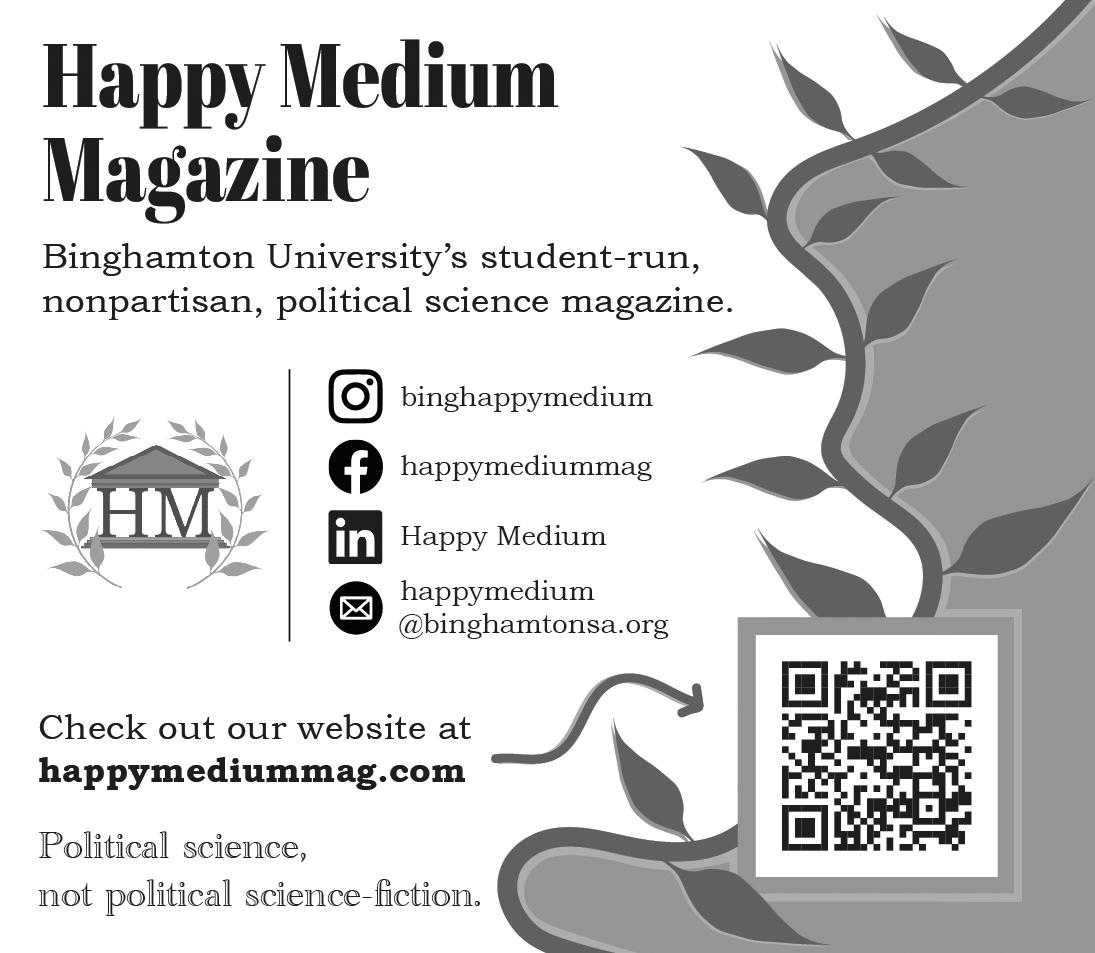
“I’m happy to have this space on the Spine to speak out on what’s going on in Greek life,” Werner said. “I hope that it will bring awareness to more students about the possibilities of a university without Greek life — the alternatives. So yeah, I’m just

happy to be here.”

A similar sentiment was expressed by Isabel Gurwitch, historian for WSU and a senior majoring in human development.
“I hope that when people see this, they know that they are not alone in the way they feel about Greek life and that they can find community apart from Greek life,” Gurwitch said. “And that the way that they feel they have been marginalized is the way that a lot of people feel and that Greek life really is harmful.”
With the Week of Action now over, Fitzgerald explained their feelings on making students understand their beliefs regarding Greek life.
“It is absolutely necessary to critique and challenge systems which contribute to or perpetuate existing inequities and injustices, and Greek life is no exception,” Fitzgerald wrote.
“We want our peers to understand that while involvement in Greek Life may seem innocuous or personally beneficial in some ways, it ultimately upholds larger oppressive cultural, political and economic structures, and there are much less harmful ways to socialize and form community. We can imagine and create healthy and just communities for ourselves without replicating oppressive behaviors, and we have a unique opportunity to do so as young people and as college students.”
Kraham has recently warned four Binghamton properties in violation of the new law.
In a week dedicated to highlighting the ways Greek life can be harmful, WSU held multiple events to educate students and foster conversation.
Caspar Carson Photo Intern
One of the properties warned under the “Lockdown Law” is The Cave, an upscale bar in Binghamton, which has hosted birthday parties, drag shows and several campus-related events.
bupipedream.com October 4, 20224 NEWS
Blake Owen Contributing Photographer The final event of the Week of Action was, “Chalk the Spine,” where participants wrote various messages against Greek life.
Women’s soccer defeats Vermont 6-1 on the road
FROM SOCCER PAGE 1
On Sunday, the Binghamton women’s soccer team continued its unbeaten streak on the road against Vermont. After defeating NJIT on Thursday, the Bearcats put on a dominant offensive effort in Burlington as they took care of the Catamounts 6-1, taking the sole position of first place in the conference despite playing one less game than the teams behind them.
“Very pleased with the way the team responded,” said Binghamton head coach Neel Bhattacharjee. “We were down a goal early, giving up an unfortunate [penalty kick]. So we had to show some resilience to come back from that and we did.”
BU (6-4-2, 3-0-0 America
East [AE]) conceded a goal to Vermont (3-6-2, 0-2-2 AE) early from a penalty kick. However, this was the only goal the Bearcats gave up for the remainder of the match.
“I thought that first goal started to change the trajectory of the game,” Bhattacharjee said. “We started to get more goals from there, and as the game went on, we got more confident.”
Despite giving up an early score, Binghamton did not waste time responding, as sophomore forward Peyton Gilmore found the back of the net in the 18th minute. This goal sparked two more for the Bearcats within the next six minutes of play. Senior forward Maya Anand scored the first of her three goals just under the 20-minute mark. Less than three minutes later, Gilmore
scored her second goal of the game to put BU up 3-1.
The Bearcats continued their offensive dominance for the rest of the first half. Anand put backto-back unassisted goals into the net less than 10 minutes apart, her eighth and ninth goals of the season. The senior became the first Bearcat to record a hat trick in one half, and she also tied the program’s record for points in a game with seven. The senior now leads the conference in goals with nine, three more than anyone else.
“A decent amount of [Anand and Gilmore’s] opportunities actually come from their defending,” Bhattacharjee said. “We require our forwards to do a bit of defensive work and they did that … They create opportunities in terms of how
they defend and how they work … There’s a few different ways they can be dangerous in our attack, and it’s difficult for America East defenders to have to cope with that.”
In the 39th minute, senior midfielder Olivia McKnight scored Binghamton’s final goal of the game off of an Anand assist. BU fired 13 shots in the first half, going into the break with a 6-1 advantage.
“I thought we were very efficient in terms of our shooting,” Bhattacharjee said. “13 shots in the first half turning into six goals … So I was very pleased with our attack, and that we took advantage of the opportunities that were presented to us.”
Binghamton spent the majority of the second half
defending its own goal. The Catamounts threatened by firing 15 shots in the period but were unable to put any shots into the back of the net. Sophomore goalkeeper Kaitlyn Williams played a major role in halting Vermont’s offense. The Bearcat made seven total saves with six coming in the second half and three coming within a minuteand-a-half of one another.
“[Williams] did well,” Bhattacharjee said. “[Vermont] started to get some looks in the second half … Most of the shots were right at [Williams], so she didn’t have to make spectacular diving saves. But that’s credit to her, she was able to stop the ball, was in good position, had a good angle on all of the shots, so well done by her.”
After three conference
matches, Binghamton is now 3-0 in AE play. Its unbeaten streak is now at six games as they move into the middle of the conference season.
“I think we have to give credit to the trajectory of the season,” Bhattacharjee said. “We played a very demanding non-conference schedule. We played Buffalo, Syracuse [and] Michigan State — these are all top-100 RPI type of teams. Even though we took some hits, what I love is how the team adjusted and grew from those experiences … It’s given us an opportunity to get out to a good start in America East play.”
BU returns home on Sunday, Oct. 9 against New Hampshire. Kickoff is scheduled for 1 p.m. at the Bearcats Sports Complex in Vestal, New York.
Men’s soccer earns third draw against NJIT
Roorda saves three shots.
On Saturday, the Binghamton men’s soccer team traveled to NJIT for the squad’s second American East (AE) conference matchup of the season. After snapping their 16-game winless streak last Tuesday in a recordsetting scoring affair against Hartford, the Bearcats’ offense was quiet the entire evening while their defense remained stout as they earned a scoreless tie.
from senior back Michael Bush, whose attempt flared out right. On the defensive end, BU was outshot 11-1 in the first half, but still managed to keep the game scoreless. Binghamton came out with a different plan in the second half and flipped the switch, beating NJIT in shots eight-to-seven.
90 minutes, Lazaridis had an opportunity to put the Bearcats ahead in the closing seconds of the game. Bush launched the ball above his ahead from the sideline while the ball found the Lazaridis in the 18-yard-box. The redshirt junior attempted a shot that was headed toward bottom center, but his chance was squandered by the Highlander defense with a sliding save as time expired.
BU (1-6-3, 0-1-1 AE) was held to one shot in the first half by the Highlanders’ (3-3-4, 0-0-2 AE) suffocating defense.
Senior goalkeeper Mats Roorda started between the pipes for the Bearcats, stopping all three of NJIT’s shots on goal, and coming away with a clean sheet after 90 minutes of play. On the offensive side, the Bearcats managed nine shots total with one shot on goal apiece by junior midfielders Shawn Coles and Markos Touroukis, graduate student forward Ethan Homler and redshirt junior midfielder Anthony Lazaridis. However, BU was unable to find the back of the net, ending the match scoreless for the seventh time this season.

In the first half, the Bearcats mustered just one shot coming
“We made a couple of slight adjustments, moved some faces around and brought a new player in,” said Binghamton head coach Paul Marco. “I think that helped us a little bit. We talked about how we were going to solve some of the things where they were getting on the ball, and I think we negated that a bit better than in the first half.”
Roorda recorded his second solo shutout of the season, totaling three saves. His previous one was against Canisius two weeks prior. Roorda is now fourth in the conference in average goals against, with 1.18 goals allowed per game in seven starts.
“I thought [Roorda] has been terrific the last few games,” Marco said. “He had to make a pretty good save on a set piece in the second half, and he dealt with that [with] no issues. I [also] thought that his game management was excellent and his communication [with] the guys was very good.”
After multiple chances throughout the course of the
“I think one of the things we wanted to improve in was our competitive spirit and competing,” Marco said. “I felt like we were really good at that today … We’ll go to Bucknell on Tuesday with [five] goals in mind — play well, perform well, compete hard and get a lot of guys minutes in the game. [Also] make sure that we put our best first forward.”
This tie is the third of the year for BU and marks the second-consecutive game where the Bearcats walked out without a loss. Since starting 0-4, BU is 1-2-2 since Sept. 9. With Saturday’s tie, Binghamton recorded its first point in conference play, putting them tied at fifth in the America East with five conference matches left.
BU returns to action against Bucknell on Tuesday, Oct. 4. Kickoff is set for 7 p.m. at Emmitt Field at Holmes Stadium in Lewisburg, Pennsylvania.
Cross country teams compete at Lehigh Paul Short Run
Seth Schlank Sports Contributor Ian Mills Assistant Sports Editor
On Friday, the Binghamton cross country teams made the trip to one of the most prestigious collegiate meets in the country at the Lehigh Paul Short Run. After everyone crossed the finish line, the women placed in the top half of teams at 21st out of 46 teams, whereas a depleted men’s squad finished 44th.

“The Lehigh Meet is probably gonna be one of the most competitive meets in the country this year,” said Binghamton head coach Annette Acuff. “On the women’s side, we had everyone healthy. Everyone was there and got a chance to compete, so it went really well … On the men’s side, we’re missing several guys, unfortunately. We couldn’t change the race assignment last minute.”
The highlight of the race for Binghamton came from graduate student Sophia Ryan, who recorded the fastest time ever for a BU women’s runner in the
6k. Ryan crossed the finish line in 20:05.1, which was enough for 24th place, but would have been ninth at last year’s meet. This marks the second consecutive race where Ryan was BU’s top runner on the women’s side, as the Utah transfer won the Iona Meet of Champions two weeks ago.
“That’s a great performance for [Ryan],” Acuff said. “I know that’s her lifetime best in cross country. The top 25 this year is way more competitive. I would say it was probably twice as competitive this year on the women’s side than last year, looking at the field and the teams that were there, and the times showed it.”
After Ryan, graduate student Aziza Chigatayeva finished the race in 20:23.1, while freshman Sydney Leitner crossed the line in 20:39.4, finishing in 47th and 75th places, respectively, out of 417 runners. Both times would have led them to finish much higher in last year’s event, as Chigatayeva’s finish would have placed 13th and Leitner’s 28th. This year’s race included 74 more runners than last year.
“It’s just a different field
this year, [it] was a lot more competitive,” Acuff said. “I wouldn’t go off of place, I would go off of time because it’s the same course and that is consistent. If you look at the times, the times are fantastic. I told our girls, don’t let the places fool you because there are 47 teams … and [Chigatayeva] and [Leitner] had fantastic races for themselves. [Leitner’s] a freshman, so that was her first 6k and that went really well. It can be a bit overwhelming, the first time around a big meet like that, but she handled it incredibly well.”
The men’s side was down a handful of runners and had only one runner place in the top half of the competition. Senior Matthew Cavaliere finished the men’s 8k in 24:32.9, placing 170th. This marks the third time this season that Cavaliere has placed in the front half of a race and the second time he has been the men’s top runner.
“[Cavaliere] ran a fantastic race, that was great for him,” Acuff said. “So I was really pleased with his performance, and our freshmen guys had some great performances, that was
their first 8k ever. It was great to be able to get them in a good competitive 8k so they’re better prepared for their conference meet and their regional meet down the road.”
Seniors Ryan Guerci and Marty Dolan, who each placed in the top 20 at their last race, were unable to participate in the event.
“We’re still trying to kind of get everyone healthy and ready to go,” Acuff said. “Especially for a conference meet. We won’t compete [with] everyone at ECAC/IC4A in a couple of weeks, but we’ll compete [with] most of the men’s team if they’re healthy. So unfortunately, I just didn’t have everyone healthy and sometimes that’s the way it goes.”
The men’s team competed in the Men’s College Gold while the women’s team competed in the Women’s College Gold.
The Bearcats are next scheduled to compete at the ECAC/IC4A Championships on Friday, Oct. 14. The first race is set for noon at a location that is to be determined.
Tuesday, October 4, 2022 STREAM ON SPOTIFY Pipe Dream Bearcast
Ryan clocks fastest time in women’s program history at this meet.
Provided by Jonathan Cohen
Senior goalkeeper Mats Roorda recorded a clean sheet with three saves in a scoreless tie with NJIT on Saturday.
Provided by Gary Mui
Graduate student Aziza Chigatayeva placed 47th overall with a time of 20:23 at the Lehigh/Paul Short Run on Friday.
Volleyball sweeps New Hampshire 3-0 away
BU wins first AE matchup of season, improves to 10-4 overall.
Johnny Yang Sports Intern


On Sunday afternoon, the Binghamton volleyball team defeated New Hampshire in its first matchup of America East (AE) conference play.
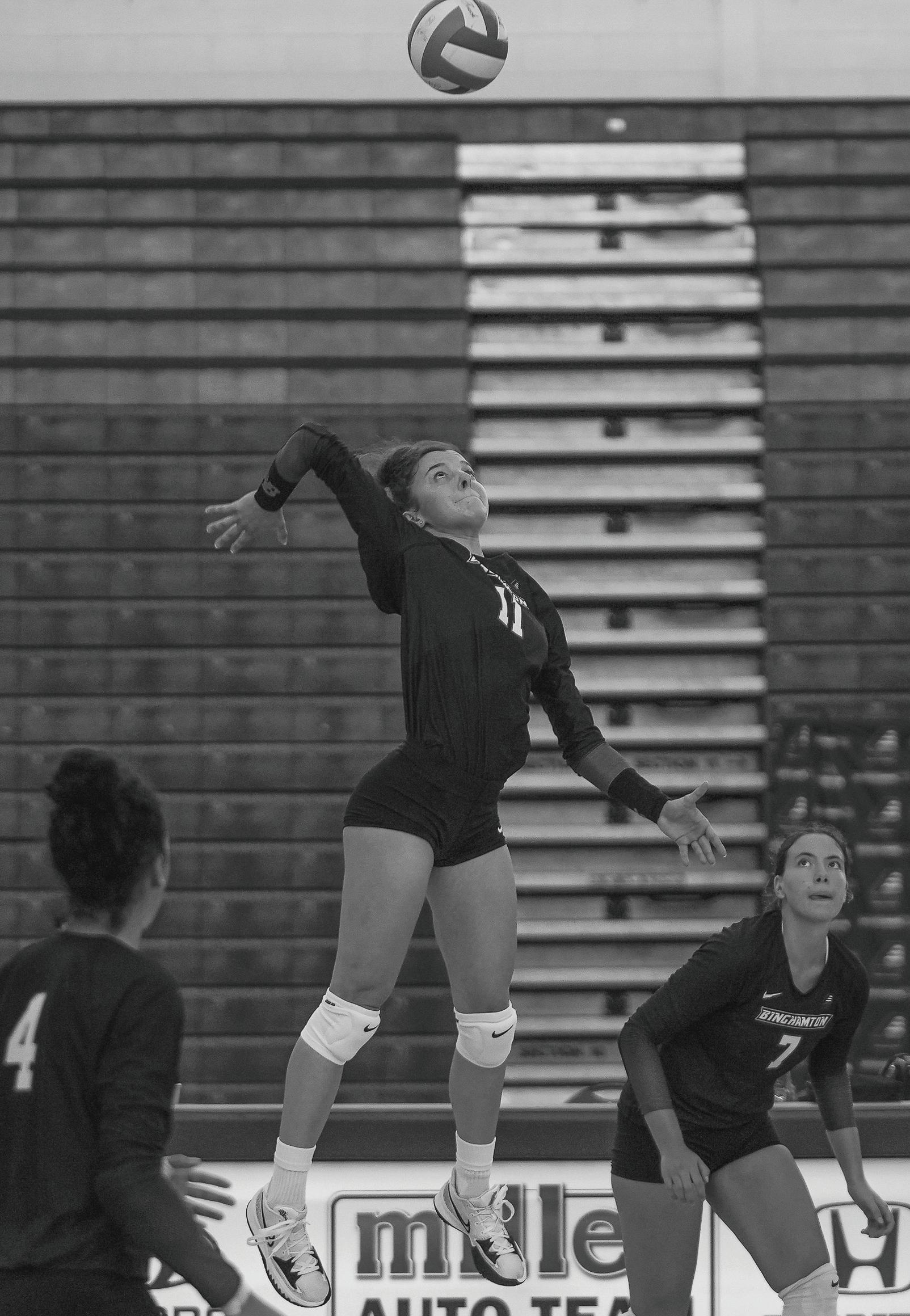
The Bearcats were relentless throughout the match, not allowing the Wildcats to take a single set and defeating them 3-0.

“Getting that first conference win is always one of the hardest things to do,” said Binghamton head coach Allie Yaeger. “We played very clean, simple, focused and error-free … We distributed the ball well and everybody contributed. Our defense was good and our serve receives were consistent … We just didn’t make a lot of errors.”
Despite a back-and-forth start to the match’s opening set, with both teams exchanging points, BU (10-4, 1-0 AE) was able to slowly pull away against UNH (11-6, 1-1 AE). After going up 4-3, the Bearcats held their lead for the remainder of the set.
The Wildcats, however, mounted a late comeback when they went on a run to cut the deficit to 1917, but Binghamton managed to pull away and went on to win the first set 25-19.
“I always tell the girls, that if you can get kills in out of system, you are going to be a very good team, so that’s something we have been working on all
season,” Yaeger said. “The fact that we were still able to put the ball away when our passing wasn’t great is probably what pulled us ahead in that first set.”
In the second set, BU took a quick lead. The Bearcats grew an early 10-5 advantage that continued late into the frame, when they went on to take a 2115 lead. Binghamton led by as many as eight points during that stretch. Similarly to set one, the Wildcats staged a late comeback, going on a small run and cutting the deficit to just three, forcing BU to burn a timeout while leading the set 21-18. After regrouping during the timeout, the Bearcats’ lead continued to lessen as the score was 23-22 moments later. BU did not fold however, as it earned a point off of service error and then closed out the penultimate set 2522 thanks to a kill from junior outside hitter Tsvetelina Ilieva.
“[Ilieva and freshman outside hitter Giulia Bonifacio] were so consistent for us,” Yaeger said.
“When they get set a ball, you have so much confidence that they are going to put that ball away. And our setters, when they set them, I know that’s how they feel too. When we needed a point or needed a kill, we rely on them to come through for us, and they always do.”
In the third set, the Bearcats initially struggled to find their groove. UNH controlled the lead early until Binghamton matched the score at eight points a piece. BU then began to pull away and eventually lead the set 23-16. After another small 3-0 run by the Wildcats to make the score 23-19, the Bearcats called a
timeout. New Hampshire closed the gap but was unable to take the lead. Despite a slow start, BU eventually took the set 25-20, securing its first AE win against the Wildcats.

“We were just very focused,” Yaeger said. “They were very confident and you could tell that they trusted each other … They relied on people to put the ball away, and they got excited for each other … I just reminded them we were in the driver’s seat. We had full control over that match the entire time. I never didn’t feel in control.”
Bonifacio and Ilieva led the team on offense, with a combined 30 kills and only seven errors. Overall, the team had a combined hitting percentage of .302. Freshman setter Lottie Scully set up her teammates all game, finishing the match with a team-high 34 assists. She also contributed on the defensive end with 12 digs of her own in the victory. Junior right side hitter Stephanie Gatto also reinforced the defense with four blocks, as the Bearcats’ defense altogether held the Wildcats to a hitting percentage of just .177.
“I think it was a statement for us,” Yaeger said. “I don’t think people know what to expect from this team. To go in on the road and win in 3 … It was huge. It was everything and more than I wanted and could have imagined.”
BU continues conference play on Friday, Oct. 7 against UMBC. First serve is scheduled for 7 p.m at West Gym in Vestal, New York.
Mason Brody-Lewis Assistant Photo Editor
bupipedream.com October 4, 20226 SPORTS
Junior outside hi er Tsevetelina Ilieva tallied 15 kills for BU in a 3-0 win against UNH on Sunday.
OPINIONS
Food apartheid must be addressed
Low-income, minority Americans lack access to healthy food.
Kathryn Lee Columnist
Food insecurity is one of America’s most insidious problems. In one of the richest nations in the world, one in 10 people live in food-insecure households . But these households are not a monolith. Food insecurity occurs in pockets across the country and in a wide array of situations. Perhaps most importantly, food insecurity disproportionately affects Americans of color and functions as a reminder of systemic injustice that must be corrected.
Food deserts are “geographic areas where residents’ access to affordable, healthy food options (especially fresh fruits and vegetables) is restricted or nonexistent due to the absence of grocery stores within convenient traveling distance.” Food deserts occur disproportionately in lowincome neighborhoods and among communities of color. Decadesold redlining initiatives prevented Americans, particularly Black Americans, from moving upward economically. According to Tufts University professor Julian Agyeman, “A process of ‘supermarket redlining’ has seen larger grocery stores either refuse to move in to lowerincome areas, shut existing outlets or relocate to wealthier suburbs. The thinking behind this process is that as pockets in a city become poorer, they are less profitable
and more prone to crime.” Food deserts are the vestiges of previous government practices designed to systematically prevent racial equality. If grocery chains refuse to enter more impoverished areas and if the residents in those areas are intentionally prevented from building wealth, then a vicious cycle emerges in which grocery stores may never be willing to branch out into less wealthy neighborhoods.
Moreover, food deserts often occur in conjunction with “food swamps” — areas with food options that are overwhelmingly less healthy, such as fast-food restaurants, convenience stores and drugstores. While intervention in food deserts is usually aimed at increasing access to healthy foods, in food swamps, there is also a strong focus on reducing access to unhealthy food. Routine consumption of fast-food explains why minority and low-income communities have higher rates of diet-related conditions like obesity, type 2 diabetes and cardiovascular disease, than other Americans.
Food deserts emphasize the already present distinction between the diets of higher-income and lowerincome Americans, with higherincome Americans eating multiple more servings of vegetables, whole grains and other healthy foods.
On the contrast, lower-income Americans drink “5 more sweetened beverages” a week. Moreover, the dominance of large corporations, such as McDonald’s, suggests that
it is far easier for producers of fastfood to multiply in lower-income neighborhoods where consumers can more easily afford cheap goods rather than fresh produce, than it is for smaller grocery store chains or mom and pop shops to sustain themselves.
But even the term “food desert” is flawed — it conjures up images of barren lands in a vague Old West setting when, in reality, food deserts often occur in urban settings like New York City, where about 750,000 people live in food deserts. Activist Karen Washington has proposed an alternative moniker — “food apartheid.” Washington argues that “food desert” is an “outsider” term that is prescriptive rather than nuanced while “‘food apartheid’ looks at the whole food system, along with race, geography, faith and economics.” Washington’s “food apartheid” rejects the notion of monolithic, spontaneous food deserts and instead recognizes that lack of access to food is not simply spontaneous. It is rooted in programs of systemic racism, like redlining, that have purposely created and barricaded poor communities of color from adequate food supplies.
It’s important to recognize that a food apartheid doesn’t just concern food moving from the market to the consumer — an unjust food system also includes the skewed access farmers of color have to subsidies. For many years, the USDA
systemically favored white farmers by denying or delaying loans to Black farmers. A 1994 USD report found that “loans to Black male farmers were, on average, worth 25 percent less than those given to white males. And 97 percent of disaster payments went to white farmers, while less than 1 percent went to Black farmers.” Today, only 45,000 of the 3.4 million farmers in the United States are Black, as opposed to 1 million in the early 1900s, but farm subsidies are still overwhelmingly given to white farmers. People of color are excluded from the food system not only in the production stage but also in the distribution and acquisition stages.
Advertising and the selection of goods within grocery stores, even those that are not in food deserts, also play a role in the nation’s nutrition gap. Activists posit that a lack of education is partially to blame for why lowerincome Americans consume more unhealthy foods than higherincome Americans. Some goods, like vegetables, are widely known as healthy, while foods such as white rice are not as evident. Advertising for fast-food and junk food is also viewed overwhelmingly by people of color — “Black children and teens viewed about 75 percent more fastfood TV ads in 2019 than their white peers… between 2012 and 2019, fast-food restaurants increased ad spending on Spanish-language TV by 33 percent.” It is a combination
of all of the aforementioned factors — a lack of wealth, a lack of education and a lack of protection from predatory advertising — that prevent Americans from making better nutritional choices.
Binghamton University and surrounding areas are denoted by the USDA as a food-insecure region, because it is a low-income tract where residents are significantly far from a supermarket. It is unclear, however, whether the income measurements are skewed because the vast majority of people living in this tract are students.
Regardless, students know the struggle of reaching the local Target or Walmart all too well, having to transfer from bus to bus and walking on narrow sidewalks bordering Vestal Parkway. In 2021, however, Binghamton’s North Side ended a 25-year designation as a food desert when Greater Good Grocery opened.
Funding “came from state and federal grants and donations from local foundations,” emphasizing the feasibility of a collective solution to food insecurity.
But Binghamton’s recent triumph is also a reminder that there is no one-size-fits-all solution for food insecurity. Efforts focusing solely on opening new grocery stores in other food deserts have been underwhelming. Though nearly a hundred grocery stores have opened in Pennsylvania since 2001, for instance, many residents still struggle with diet issues.
Similar proposals to impose soda taxes and zoning laws with quotas on fast-food restaurants have proven controversial and ineffective. More thoughtful reform — including more emphasis on nutrition education and stronger connections with local communities — is needed rather than throwing money at the issue and searching for the least intensive solution. Caution should be exercised when attempting to address the issue of food deserts — real change can only be brought about by a recognition of Karen Washington’s food apartheid, a far more complex interpretation of all of the factors that lead to nutritional inequality. Rather than linking food insecurity with unpopulated “deserts,” initiatives should be taken to humanize those in need. Lack of access to food impacts real people in real situations, particularly people and situations that have been affected by systemic racism and government mismanagement. Efforts addressing food insecurity should be coupled with efforts to eradicate the lingering effects of redlining, efforts to hold government agricultural agencies accountable and more.
Food is a human right. Allowing millions of Americans to eat themselves into dire health issues because they cannot help themselves is an immoral status quo.
Kathryn Lee is a sophomore double-majoring in English and economics.
The college ranking system is flawed
College rankings are insufficient measures of the value of universities.
Columnist
The title “Ivy League” immediately draws associations of elitism, money, academic excellence and selectivity — and now, scandal as well. Established in 1754, Columbia University is one of the eight Ivies and has long been renowned for its status as one of the most prestigious schools in the United States. That was, of course, until the recent news revealing that Columbia University published misleading data to increase their rank in the annual U.S. News & World Report survey of American universities, rehashing the debate about what the societal value of a college education is worth and how it shapes students’ futures.
Dr. Michael Thaddeus, a professor of mathematics at the university, asserted in March that Columbia was undeserving of its No. 2 place in the U.S. News & World Report’s ranking. In a published analysis on his website, Thaddeus maintained that the data Columbia provided was “inaccurate, dubious or highly misleading.”
Questioning Columbia’s rapid ascent from 18th place since its introduction to the list in 1988,
Thaddeus compiled inconsistencies between the university’s official data and the actual affairs at the school. Eventually, he concluded that Columbia University’s data — including factors such as class size, university spending and student-tofaculty ratio — was more uncertain than it appeared.
Despite initially defending its data, Columbia recanted their previous statements, admitting their data was inaccurate and Dr. Thaddeus’ assessment was correct.
Columbia dropped from 2nd place on the rankings list to 18th, and questions began to arise not only about their ethics, since academic honesty is such a cornerstone of the university, but about wider concerns regarding colleges and universities in America, including the value of rankings.
Columbia is certainly not the first to lie to increase its standing and absolutely will not be the last. Many students choose schools solely based upon their rank, believing that a number on a list is determinative not only of their intelligence, but of where they will wind up in life after graduation. Nearly every institution of higher education in the country, including Binghamton, publishes
and praises these rankings as if they were gospel. It’s not hard to miss either — posted all over campus are signs declaring that Binghamton is the “Number one public school in New York.”
So, what determines the value of any education? As it turns out, arbitrarily ranking schools based upon presupposed data that may or may not be accurate informs us little about the actual value of an education. The process for the rankings is fairly simple — each university wanting to be included sends in their own data, and the U.S. News & World Report then calculates where schools fall based on their own weights of what matters. Graduation and retention rates, based in part on a peer assessment survey, are the most heavily weighted categories at 22 percent, faculty resources (including data such as studentto-faculty ratios and class sizes) at 20 percent, and expert opinion, completed by presidents, provosts, and deans of admissions ranking other schools at 20 percent.
Clearly, the margins for error are extremely high. Universities provide their own data with little check as to whether or not the information is accurate, and highly
arbitrary factors, such as having different higher education “experts” rate schools, leads to extremely subjective ranking. While one student may thrive in a school with a small student-to-faculty ratio, this might not be true of every student, and weighing measures such as this heavily presupposes there are better ways to learn than others. American university culture, so long built upon competition, elitism and selectivity, thrives upon rankings, ensuring students end up caring more about a ranking than what a particular program or school could provide for their future.
Ultimately, Columbia University’s scandal may serve to do us some good. Revealing the worthlessness of groundless and discretionary means by which most college rankings are based may finally unveil the fact that, perhaps, the value of a college education is what you make of it and depends on the students. Hardworking, intelligent students can be found at any college campus across the country — name, number and price tag tell us nothing about the skills and pedagogy at a university.
What top-tier universities with extra funding do offer is a network
within America’s elite, thereby opening opportunities that may otherwise not have been available. Schools ranked higher also usually tend to have better academic counseling, accommodations, internship and job resources, whereas lower ranked schools are often neglected in these aspects. However, the education you receive — and, more importantly, the outcome of that education, including jobs and graduate degrees — is mostly dependent on the student. There are very few numbers or data sets by which one can separate a “bad” education from a “good” one.
This is not to say all rankings are completely useless. One of the more useful ways of ranking schools is found on Forbes’ annual list of college rankings, where the heaviest weighted factors include alumni salaries and debt after graduation.
These categories are far more important and influential than “peer assessment reviews,” as the return on investment that an education can provide is extremely important in choosing a school and may be one of the only worthwhile ways in which we can effectively rank the value of American higher education.
Diver noted his critiques in a November 2005 article for The Atlantic.
“Trying to rank institutions of higher education is a little like trying to rank religions or philosophies,” Diver wrote. “The entire enterprise is flawed, not only in detail but also in conception.”
Diver is correct — attempting to rank universities by subjective measures of merit such as faculty opinion serves no outwardly good purpose and in fact, is more harmful than helpful. Hopefully, Columbia University’s wrongdoing will put us on the path toward a society where rankings are no longer the emphasized measure of the value of education and the success of students.
Samantha Rigante is a sophomore majoring in philosophy, politics and law.
“Ag-gag” laws protect harmful factory farming practices
Alexis Fischer
Samantha Rigante Columnist
Factory farming is a heartless practice that prioritizes profit over the well-being of animals and the environment. According to the Humane League, routine aspects of factory farming include “various bodily mutilations, extremely tight and crowded confinement and lives spent entirely indoors.” Additionally, animals at factory farms are raised to grow quickly in order to be turned into products faster. Animals are hurt in all stages of these practices.
Factory farms almost always get away with this behavior, and workers face no charges thanks to the laws protecting this inhumane industry.
So, why does factory farming still exist? Well, the invisibility of the problem makes it almost impossible to solve. There are regulations called “ag-gag laws” that protect these
terrifying conditions by making it illegal to expose such behavior.
After Upton Sinclair’s “The Jungle” exposed the unsafe meatpacking industry in 1906, workers and owners in the factory farming industry became worried about whistleblowers following in Sinclair’s footsteps. Between this uprising and the rise in activism, ag-gag laws were born. These laws make it legal to both punish any activist that reveals footage of factory farming conditions and silence whistleblowers. Many citizens are unaware of such animal abuse occurring since there is such an effort to hide the practice. Of course, criticism of harmful habitat conditions circulates regularly, but until the specifics of factory farming are researched, most individuals are blind to how bad it really is.
Animals’ physical and mental well-being must be accounted for and they should have the right
to certain freedoms, which are undermined by ag-gag laws. In 1966, the Animal Welfare Act was passed to regulate the treatment of animals used in practices such as research, exhibition, transport and other routines. The Humane Methods of Slaughter Act of 1958 requires proper treatment and slaughtering of the animals involved. However, according to Alicia Prygoski of Michigan State University College of Law, modern-day or post-2011 ag-gag laws were presented in response to undercover activists concerned with the treatment of animals in general. She explained the debate over the real reason — “Proponents argue that they are a safeguard to protect well-meaning farmers against animal protection organizations who present the footage in a misleading way, while opponents argue ag-gag laws are meant to hide animal abuse from
the public and that these laws allow industrialized farming operations to put profit ahead of farmed animal welfare.” With ag-gag laws in place, animals will never get justice for the way they are harmed and workers will keep getting away with it.
Factory farming allows companies to produce meat more cheaply and faster. However, factory farming’s benefits are not as glorious as they sound. The speed of production and careless approach to maximizing profit ignore most health and safety regulations in an environmental sense and in terms of food safety and workers’ well-being.
Since ag-gag laws are modern, the regulations only attack the sharing or possession of recorded audio or video proof, not necessarily written text. Knowing there are loopholes, how can the public stop them? Joining support organizations like the Animal Legal Defense Funds,
who oppose anti-whistleblower bills, and share evidence of poor farm and living conditions — whether that be telling friends or sharing facts online — to help raise awareness of this hidden problem. Additionally, legislation that protects animal welfare should be lobbied for. If the public can push factory farming corporations to overcome the selfish ignorance they have toward safety regulations, ag-gag laws can finally be recognized as problematic.
To conclude, ag-gag laws are an insult to the public voice and are unconstitutional. Not only is undercover reporting critical for certain investigations, but ag-gag laws encroach first amendment rights. The public cannot practice freedom of speech if ag-gag laws prevent activists from speaking the truth about animal abuse. This is why undercover investigations are so useful in cases like this — there is no
way around the lies of the industry. The regulations also stomp on any form of justice that animals deserve. Punishing an activist intending to raise awareness instead of the people committing the violent act is a direct attempt to silence the public. These laws are currently active in six states and are itching to be passed in many more. The prevention of passing these laws is now more crucial than ever, especially considering that the laws also have harmful effects outside the scope of animal welfare, such as the surrounding environment, workers’ health and food safety. With this being said, protection laws are risking way too much to benefit the economy. It’s a selfish approach that trades off more than it receives in return.
Alexis Fischer is a junior double-majoring in English and environmental science.
Colin Diver, the former president of Reed College in Oregon and the former dean of the University of Pennsylvania Law School, notably pulled Reed College from the U.S. News & World Report’s rankings in 1995, and is a loud critic of the system of ranking colleges.
Factory farms continue to sacrifice animal welfare for profit.
Tuesday, October 4, 2022
FROM CROWN PAGE 1
There were five rounds of performances the contestants competed in. The first round was an introduction, where they were introduced to the audience while walking through the catwalk and down to the audience’s level. Each showed off their personalities with a confident strong walk, adding their own flair. The second round was the cultural garment walk, where they wore the traditional garment of their choice. Miss India and Miss Philippines also performed short dances alongside their walks.
The talent round was probably the most anticipated part of the night, with contestants showcasing the fruits of their hard work. Miss Taiwan’s talent was drawing. She found her model in the crowd of attendees and then showed it to the crowd with an energetic gallop.

Miss India performed a traditional dance with two backup dancers, starting with smooth moves which gradually got more fierce to the energetic beats. Miss Korea performed a K-pop dance to The Boyz and other classic K-pop hits,
urging the audience to sing along to the songs.
Miss China performed an energetic dance duo to “Lovesick Girls” by BLACKPINK. And, finally, Miss Philippines graced the audience with her emotional voice, prompting them to wave their lights to the song.
Intersecting with the contestant’s performances were games and a raffle with crowd participation, such as musical chairs, balloon popping and charades. The highlight was a catwalk to find a “Mister Asia,” with a mini waffle maker as the prize. Other prizes included Squishmallows, an air fryer and Starbucks gift cards.
In the fourth round, audiences voted for their favorite costume.
The winner was Miss Taiwan, who brought the heat in a Guy Fieri costume with chunky knee-high boots. Miss India dressed up as Jasmine from Aladdin, complete with a man-powered magic carpet.
Miss Korea was Little Red Riding Hood, getting chased through her catwalk by a wolf-headed man. Miss China banked on the cuteness factor with a Stitch onesie and pulled out paper hearts from her outfits. Miss Philippines was Tinkerbell bestowing
candies to the crowd.
VSA crowns Miss Asia 2022 Broome Art Trail has its fourth installment
The final walk was where contestants would change into showstopping gowns. Then, they answered preliminary questions about what they wanted from the competition and their thoughts on how social support can grow on BU’s campus and beyond. This year’s top three, Miss India, Miss Philippines and Miss China were picked after their answers. The final questions for the top three concerned topics of beauty, feminism their plan to continue to represent Miss Asia after the event and their own individuality.
After long deliberation, Miss India, Nair, was crowned Miss Asia 2022.
“It was stressful at first to prepare for this event,” Bùi said. “This year Miss Asia started one month earlier so we had to work on planning logistics and interviews earlier during the summer, and it was also Joseph’s [Trần] and [I’s] first time coordinating this big of an event. However, thanks to the help of our amazing E-Board members and the wonderful contestants, the event went well and smoothly.”

This year’s Art Trail highlights artists and more than 30 local joints.
Dane McGrowder Arts & Culture Contributor
The Broome County Art Trail, an annual countywide showcase for both amateur and professional art ists, had its fourth installment this past weekend.
The Broome County Art Trail is managed by the Broome County Arts Council (BCAC) and contains 31 stops spread out between Bing hamton, Vestal, Johnson City, Maine and Whitney Point. It featured a va riety of live music performances and art exhibitions, ranging from alumi num can sculpture to jazz. Though its selection is broad, the Broome County Art Trail offers local artists an opportunity to promote their work, connect with like-minded creators, try their hand at exhibiting or any combination of the three.
Linda Ciallelo, a member of Collaborative Gallery 213 and a seasoned participant in the Broome County Art Trail, spoke about being able to advertise her realist paint ings to a wider audience — and her overall journey as an artist. As a lifelong painter, Ciallelo spent time illustrating children’s books under a
pseudonym, before moving back to Binghamton and starting a career as a bus driver. Now that she’s re tired, however, participating in the gallery’s events, such as the Broome County Art Trail, provided her with an opportunity to spread the word about her award-winning work and reenter the New York art scene.
“I’m working my way back up,” Ciallelo said. “I’ve always painted, but I’ve never exhibited, so now I’m promoting myself.”
Natalie Shoemaker, a tabletop role-playing game (TTRPG) artist, praised the Broome County Art Trail for being inviting to first-time par ticipants and veterans alike.
“I’m very pleasantly surprised at how much this community sup ports artists, how you can be a be ginner just starting out and there’s a low barrier to entry, and you can be a professional and still find your network here,” Shoemaker said. “The [Broome County Art Trail] is this really great opportunity for somebody like me, who’s kind of un sure if I want to make this a thing, to test it out and see how it feels.”
Another site in Binghamton was the Orazio Salati Studio & Gal lery on 204 State St. Artists featured at this stop included Cindy Henry, Fern Pritikin Lynn, Marlene Wahila and Sardar Kestay. The owner of the gallery, Orazio Salati, immigrated to the United States from Arnara, Italy in 1955. Salati primarily does
painting in different types of styles, paints and sizes. The works of Hen ry showed off fiber and mixed media art, displaying figures of chairs and people. Lynn’s art consisted of Raku and functional pottery with cool, contrasting colors.
Aside from supporting artists, community engagement was also a key element of the Broome County Art Trail, as evidenced in its place ment of stops — with many being placed in points of interest like the Phelps Mansion Museum and Muckles!, the Binghamton appar el store. Each stop was also clearly pointed out, with street signs ad vertising nearby sites and arrows directing people to each exhibition.
For Shawn Graham, an abstract aluminum can sculptor whose piec es provided an environmentally friendly alternative to ant hill cast ing, being able to engage with the public as they react to and interpret his work was a highlight exhibiting.
“[My favorite part is] people that talk about what they see in the shapes,” Graham said. “It’s a very in terpretive thing.”
Although the Broome County Art Trail concluded on Oct. 2, there are still opportunities to engage with Broome County’s art commu nity, such as the First Friday Art Walk, which occurs on the first Fri day of every month from 6 p.m. to 9 p.m. — with the next scheduled for Oct. 7.
Jennette McCurdy debuts novel “I’m Glad My Mom Died”
McCurdy’s novel centers on her complex relation ship with her mom and her rise in the entertain ment industry.
Emily Vega Arts & Culture Contributor
Jennette McCurdy’s titular authorial debut “I’m Glad My Mom Died” has been the center of literary discussion since before its publication early last month. And with a title like that, how could it not? Even the cover sports a smiling McCurdy holding a bubblegum pink urn, overflowing with multicolored confetti. These controversial aspects of her memoir certainly helped catapult her story into the spotlight, but its staying power must be directly credited to the astonishing realism and complexity McCurdy crafts in the words of her novel.

The curse of childhood stardom looms over McCurdy throughout her novel, which takes readers from the start of her — begrudging — acting career to the aftermath of her mother’s death as a result of cancer. The title would lead the reader to assume McCurdy harbors and has harbored an intense hatred for her mother throughout her life. The book, however, reveals a deeply disturbing yet honest description of her admiration of her mother,
and the lengths it took to unravel the corrupted mindset that resulted from her mother’s conditional and manipulative love. Starting at the age of six, McCurdy’s mother began molding McCurdy into “mommy’s little actress” by forcibly enrolling her in acting, dancing, singing and accent classes. She made McCurdy learn to pogo stick, jump rope and most notably, cry on command to increase her odds of getting hired for more roles. However, McCurdy explained the turmoil of hating acting while loving her mother and wanting to appease her 24/7.
“She wanted this [acting success],” McCurdy wrote. “And I wanted her to have it. I wanted her to be happy. But now that I have it, I realize that she’s happy and I’m not. Her happiness came at the cost of mine. I feel robbed and exploited.”
McCurdy’s mother would whiten McCurdy’s teeth, tint her eyelashes, and detrimentally enforce the concept of “calorie restriction,” which would hypothetically allow McCurdy to maintain her skinny youth and stop her “boobies” from growing in. She would also give regular genital exams and baths to her children even as they breached older adolescence. The candor and nuance that McCurdy gives her relationship with her mother is the drawing force of the book, described in a way that reveals the hardest parts
of the relationship without drawing any punches. However it still infuses a wonderful and refreshing shot of humor that tapers the heaviness in a way that does not detract, but instead allows for understanding. It was surprising to see how clearly McCurdy was able to communicate her relationship and how it affected her in the years to come, and how effectively she was able to step in and out of her childhood mindset at the height of her abuse. And, as we are taken from moments of despair and helplessness in her childhood to moments of growth and healing in her adulthood, McCurdy seamlessly guides the reader through her residual and everlasting symptoms of narcissism, neglect and manipulation. Her symptoms included anorexia, bulimia, low self-esteem, commitment and relationship issues and a refusal to see the negative effect her mom had upon her. We are truly able to see the frightful lows of McCurdy’s continuous road to recovery.
The thing that remains the most poignant in this reading experience is McCurdy’s failure to villainize her mother, despite what the title and cover may insinuate. The amount of grace that McCurdy has throughout the book is really what makes the story so hard-hitting. It is what makes the reality of her difficult past that much more inspiring, as
she leaves the memoir on a high note. Although she has separated from acting, McCurdy has a bright future ahead of her with her talent in writing and podcasting.
The reception of her debut has been nearly unanimously positive, selling out in many stores just hours after its release and receiving rave reviews from audiences and critics alike. It is a book that is widely recommended, but not just because of its brilliant prose and unique premise — although those aspects certainly do heighten the experience. No, instead, the book’s discussion of the treatment of young people in the entertainment industry is incredibly pertinent as the rise of child influencers, family vloggers and accessible fame enter societal consciousness. What McCurdy went through, not only with her mother but also with fame and The Creator — aka the haunting nickname given to the creator of “iCarly” — is emblematic of many other manipulative relationships that plague the entertainment industry today. This is why it is so important for McCurdy to exemplify not only the issues that stem from that particular relationship with someone — whether it be a mother or a manager — but to also spread awareness of the dangers of throwing young children into the shark tank that is the entertainment industry
without the proper support system or precautions.
“I’m Glad My Mom Died” is a five-star read that leaves you contemplating the ethics of childhood stardom in a way never before examined, and is available anywhere books are sold.
ARTS & CULTURE
Additionally, the audiobook available on Audible, read by McCurdy herself.
Caspar Carson Photo Intern
The Vietnamese Student Association put on Miss Asia 2022: Masquerade Ballroom on Sept. 24.
Michael Golann Photo Editor
The Orazio Salati Studio & Gallery served as the fifth site of the Broome County Art Trail, featuring five artists.
Photo sourced from SimonandSchuster.com
Jennette McCurdy’s new book “I’m Glad My Mom Died” has been well received, both critically and commercially.
BUMP brings R&B, alternative sounds to BU


shows free is it gives students the opportunity to discover something they may have not otherwise known there was a platform for,” Beigie said.
Jamie H. Nguyen Asst. Arts & Culture Editor
The Union Undergrounds was lit up by last Thursday by the year’s first Binghamton Underground Music Presents (BUMP) show, featuring Stimulator Jones and opener Native Son. The crowd swayed and jammed to the smooth sounds brought by the artists.

Aidan Beigie, vice president of BUMP and a junior majoring in business administration, discussed the process behind choosing the talents to bring to the campus.

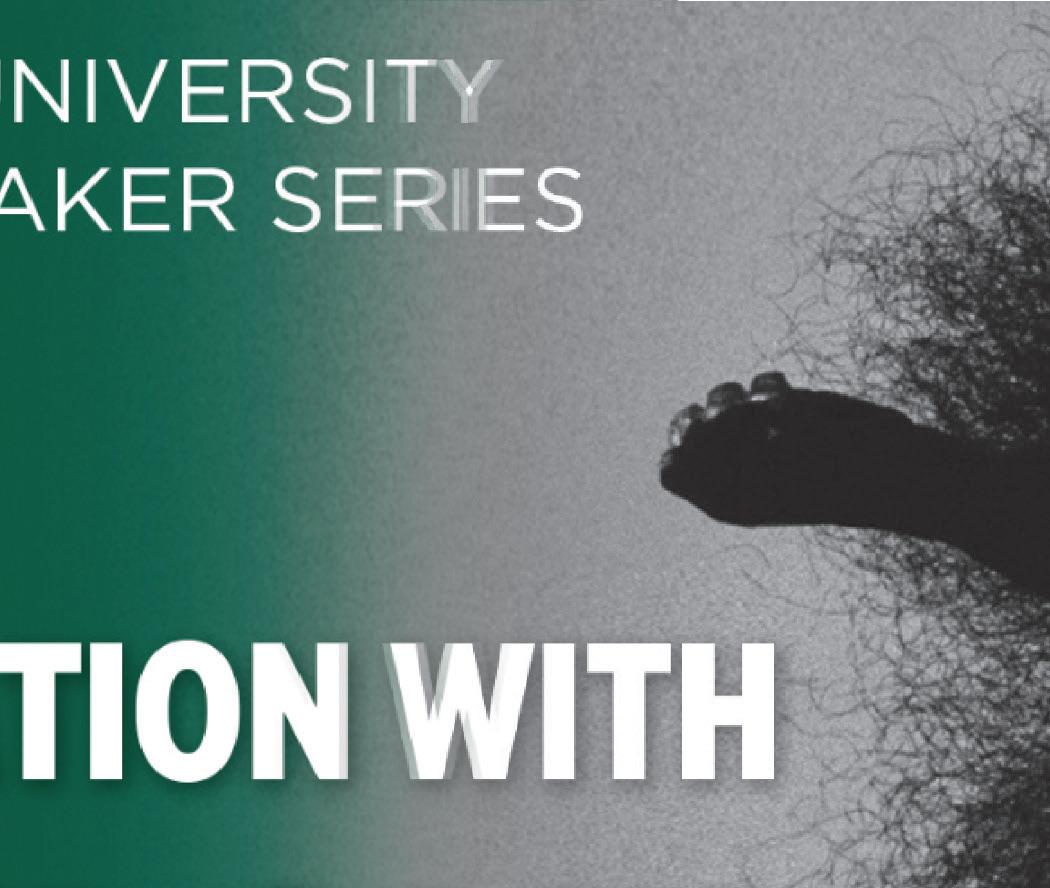



“At the beginning of each year, the committees within the SAPB compile a long list of artists that might catch the interest of people here at Binghamton [University],” Beigie said. “After that point, we send it out to all of our students as a Google Form. The form allows us to gauge what artists students are most excited about. From there, it’s all a matter of reaching out and making it happen!”
All BUMP shows are performed in the Union Undergrounds Cafe, with the only lighting focused on a small stage. This gives those present a much more intimate feeling than the usual venue, as it is closer to a house show. The show was also a collaboration with the Food Co-op, which provided an open bar with three mocktail options.
“[A] reason why we make our

Ano Chrispin, known by stage name Native Son, performed as a duo with a supporting friend. Chrispin got the crowd into the mood with songs from his first album and newer ones. His sounds ranged from strippeddown, slow and echo-heavy to low guitars. It was a combination of alternative hip-hop, punk, jazz and neo-soul. This style gives his songs very different and exciting types of compositions, where it can start with a punk guitar riff and an intersection of quiet rap, and end with soulful melodies. He ended his set with a punkier song compared to the more groovy ones before, which was appropriately named “Riot!” — prompting the crowd to bob with the energetic vibrations.

Next up, Stimulator Jones started his set with a literal “bang” with a drum solo. The first song had few lyrics and a generous amount of guitar, which immediately showed his talent as a multi-instrument musician. His range, however, wasn’t just limited to instruments. Like the 70s and 80s R&B songs that he grew up with, Jones hit highpitched harmonies with ease, which drove the audience wild.

Throughout his set, he jumped from drums to the mic, guitar and eventually the DJ table with seemingly endless energy. Even when the backing music got cut off, he kept his performance up, making the crowd laugh and whoop with him. It was a wellproduced and performed set,

especially for people who just happened to stumble into the show.
Beigie spoke about the range of music BUMP has brought to BU.
“Something we do look for year in and year out is a way to represent everyone’s music taste in the artists that we book,”


Beigie said. “Our hope is that we can appeal to all of the identities that make up our student population, as we want everyone to be able to come and enjoy our shows.”
Those interested can listen to Native Son’s two music videos from his EP “Metro Dread,” which came out on Oct. 28, and
Stimulator Jones’ newest album “Round Spiritual Ring,” now on all platforms. Both are fully written and composed by their respective artists, and worth a listen if any of their genres’ inspirations is of appeal.
Beigie reflected on the show after it ended, describing it as a success.
“The energy that everyone brought to this first show was amazing,” Beigie said. “Special thanks go out to the SAPB E-Board, the Binghamton Food Co-op and the Union Undergrounds staff for all the help in bringing the event together. We are looking forward to what’s next!”
Featured artist Stimulator Jones puts on an exciting show, playing multiple instruments live.
Kai Depalma Sta Photographer
bupipedream.com October 4, 2022 9ARTS & CULTURE
Virginia-based R&B artist Stimulator Jones headed to upstate New York for the BUMP show.








Monday, April 3, 2017Thursday, September 28, 2017Monday, October 2, 2017Thursday, October 5, 2017Tuesday, October 4, 2022 F UN “An Esteemed Institution’” - @laney_bonora “A Tale of Commercialism and Curly Fires” - @laney_bonora “Beta Biology” - @alannaburlee “That’s Not My Name” - @laney_bonora www.puzzles.ca/sudoku/ Sudoku



























































